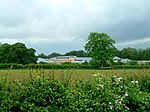Broomfleet railway station
DfT Category F2 stationsFormer Hull and Selby Railway stationsNorthern franchise railway stationsPages with no open date in Infobox stationRailway stations in Great Britain opened in 1840 ... and 3 more
Railway stations in the East Riding of YorkshireUse British English from January 2017Yorkshire and the Humber railway station stubs

Broomfleet railway station serves the village of Broomfleet in the East Riding of Yorkshire, England. The station is on the Selby Line 14+1⁄2 miles (23.3 km) west of Hull. The station, and all trains serving it, are operated by Northern. Formerly located on a quadrupled section of line with platforms on the outer ('slow') lines only, the station was rebuilt when the section from Gilberdyke was reduced to double track around 1987.
Excerpt from the Wikipedia article Broomfleet railway station (License: CC BY-SA 3.0, Authors, Images).Broomfleet railway station
Carr Lane,
Geographical coordinates (GPS) Address Nearby Places Show on map
Geographical coordinates (GPS)
| Latitude | Longitude |
|---|---|
| N 53.74 ° | E -0.67098 ° |
Address
Carr Lane
Carr Lane
HU15 1RQ , Broomfleet
England, United Kingdom
Open on Google Maps







